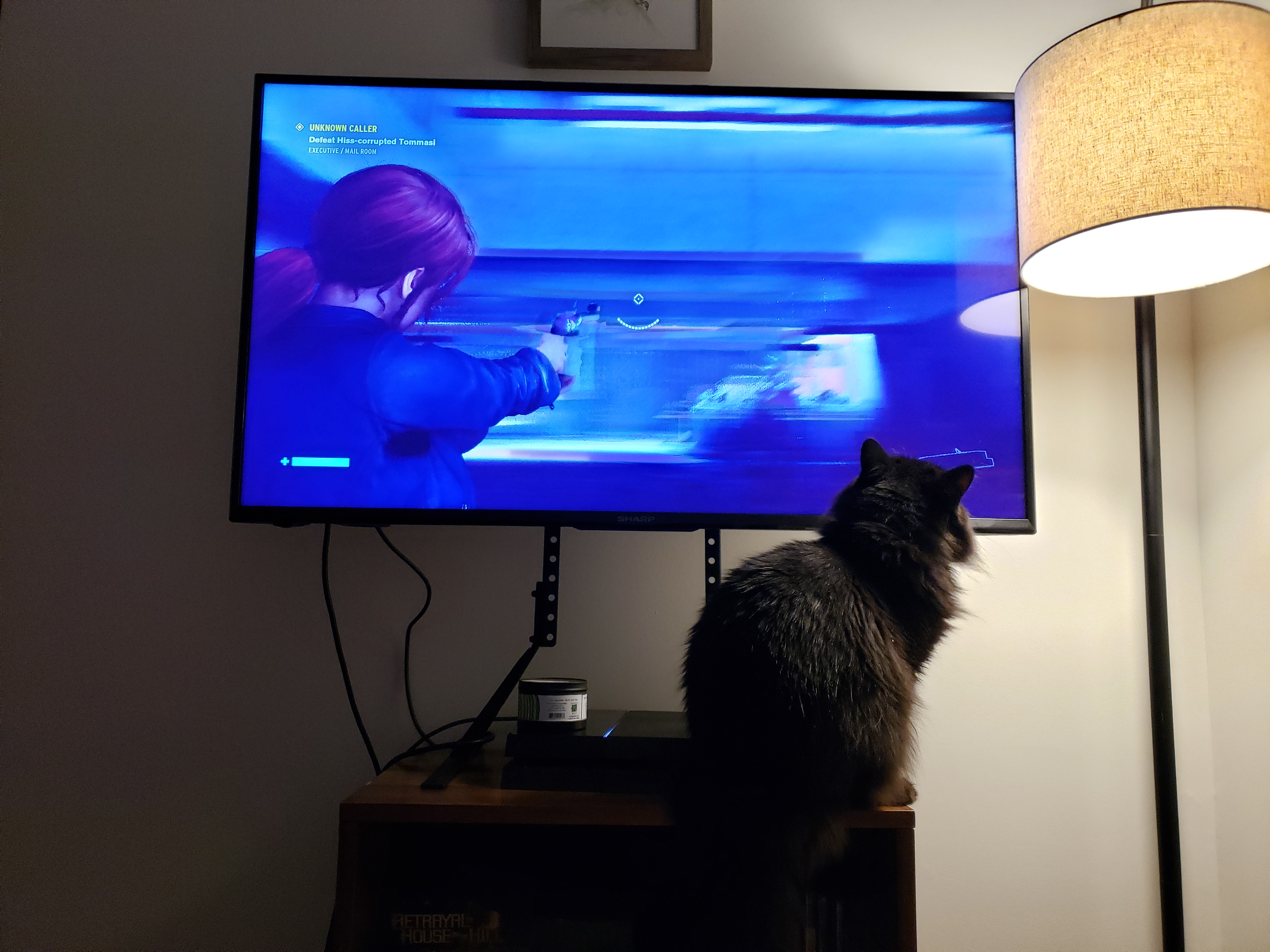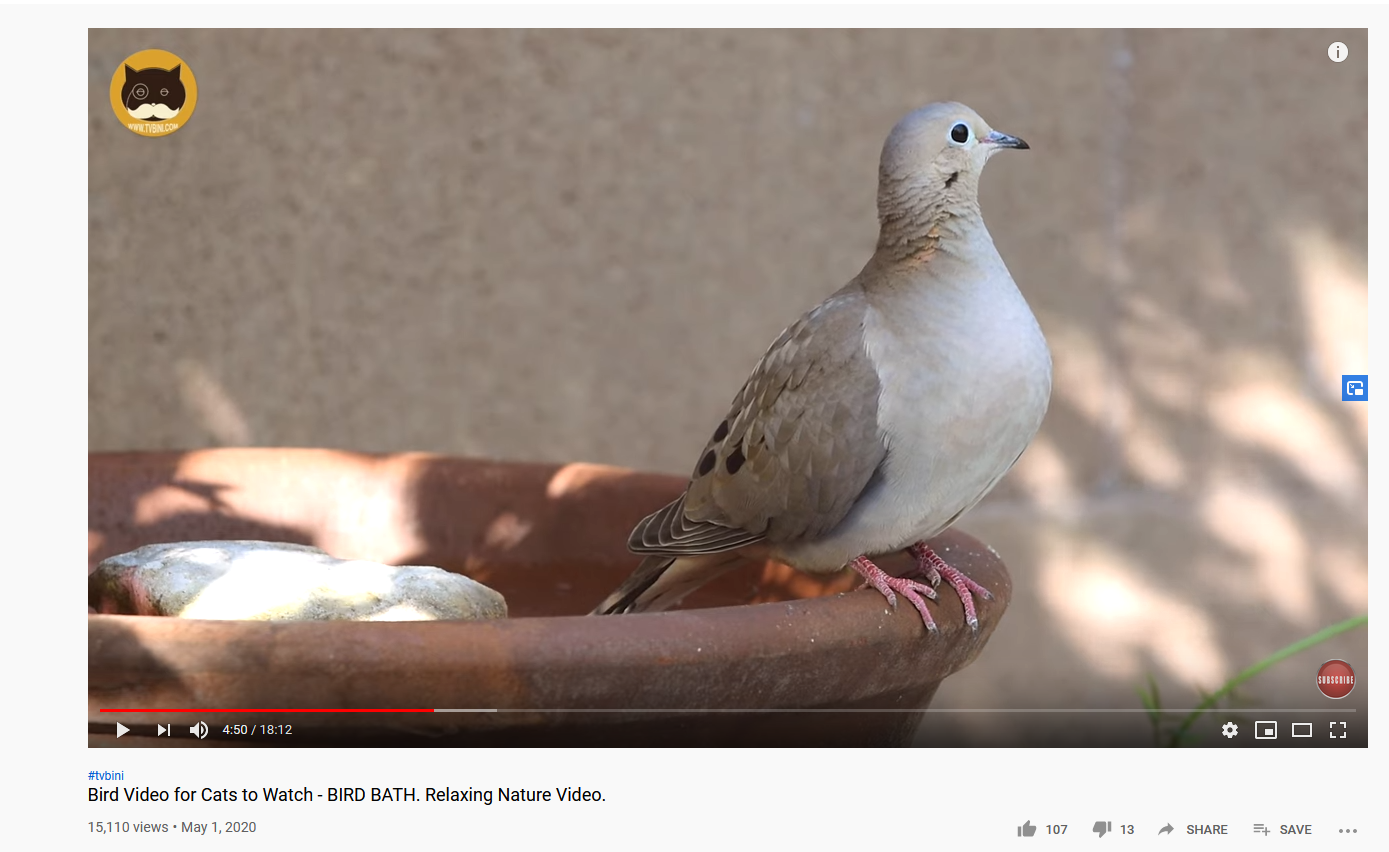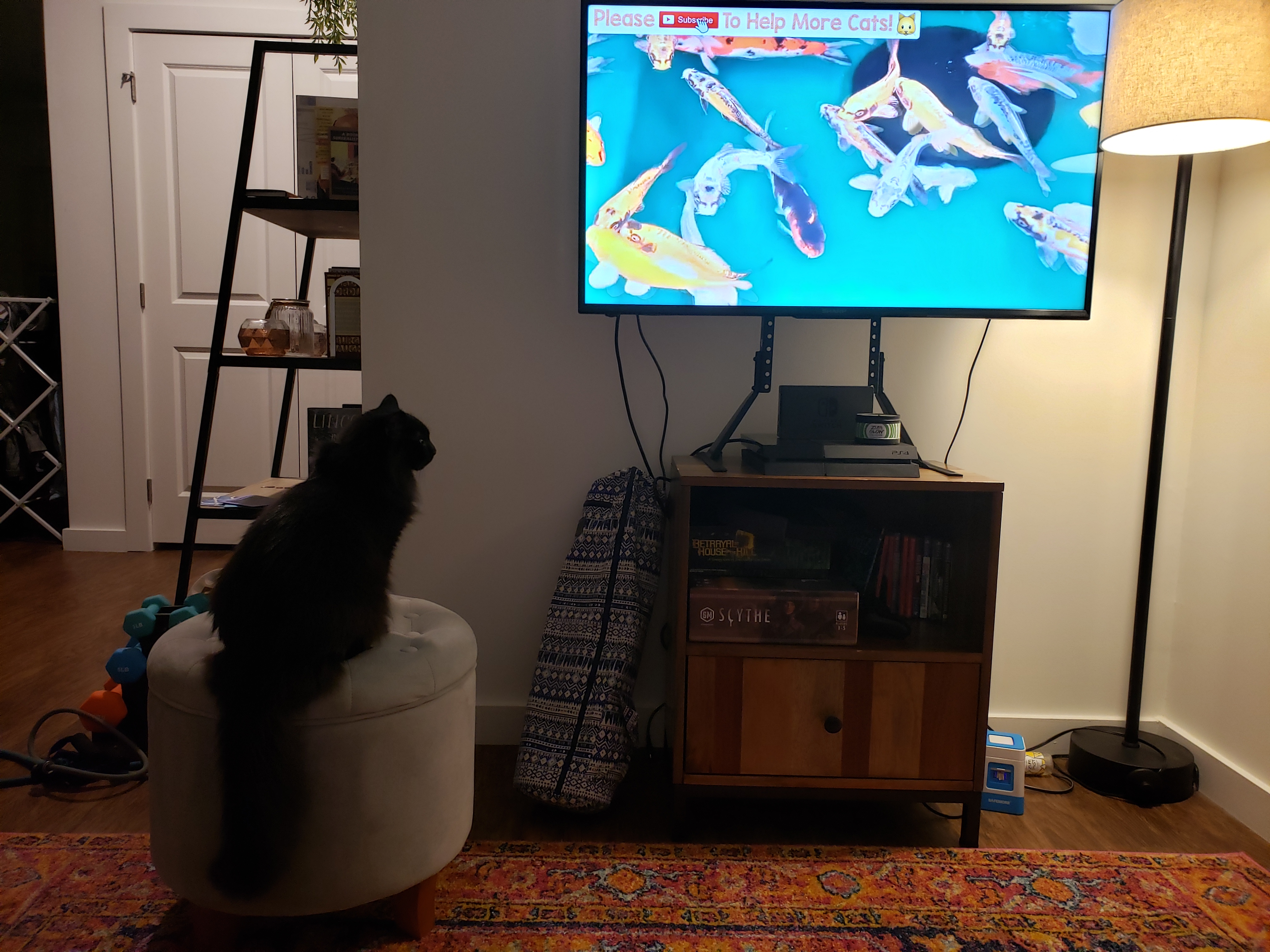Since the pandemic started, I've been using YouTube far more than I used to. Workout routines, sewing tutorials, mindless feel-good clips of babies hugging animals: YouTube has all of these in abundance. But all of these pale in comparison to the type of video I put on most frequently. In our house, kitty TV reigns supreme.
YouTube is filled with content aimed at dogs, cats, and their owners. The varieties are endless. Birds alight at a feeder, a GoPro hidden nearby to record their comings and goings. An invisible hand drags a string toy back and forth. Fish in a koi pond bobble to the surface of a pond. A camera moves smoothly through a park, capturing trees and squirrels. These videos are long, often over four hours, and the most popular ones have millions of views. I put on at least one video per day, which amounts to, at minimum, 28 hours of pet TV per week. Most YouTubers would kill for those numbers.
It wasn't always like this. But one of our cats, Graymalkin, got much more attached and energetic when I started staying home all the time. He used to sleep during the day, while I was at grad school. Then, in the mornings and evenings, he'd sit on my lap and purr as I worked. In the spring, he lost his tiny mind. He spent all day zooming around the apartment, mrrrring and chirping for attention. He begged for treats. He planted himself on my keyboard. He constantly fought my partner for control of his gaming chair.

One afternoon in July, I searched "cat tv" on the advice of a friend. Maybe some videos of birds or squirrels would take Gray's mind off the gamer chair. And it worked, at least for a little bit: Graymalkin hopped up on the TV stand and parked himself as close to the TV as he could. In his glassy, green eyes were reflections of hummingbirds. When he was most engaged, he reached up to bat at the screen with his weird little cat-hands.
After about five minutes, he curled up in my lap, bored. But I wasn’t bored. After the video ended, I put on another. And another. There were so many videos for cats and dogs. I sat on the couch, watching Graymalkin watch TV.
For both of us, it was a portal into the strange, sometimes eerie world of The Algorithm. In one video, an enormous cockroach skittered across the screen, freaking us out. In another, an otherwise tranquil recording of a bird fountain, a Minion toy loomed ominously above the birds. Every few minutes, the footage would jump cut to a slightly different angle, making it look like the Minion teleported a few inches to the left or right. Eventually, I selected so many videos from Japanese creators that YouTube, confused, started serving me ads in Japanese. While I tried to follow the plotlines of commercials in a language I don't speak, Graymalkin swished his tail, impatient for images that triggered his hunting instinct.

No video captivated his attention for more than a few minutes, but for those minutes, he was rapt. Sometimes I caught him staring at the screen even if it was switched off, as if he was trying to suss out the TV’s inner workings.
Eventually I noticed the viewer counts on the cat videos: hundreds of thousands, sometimes even millions, of views. Many of the videos came from the same channels, and these top channels were monetizing their content by running ads. How much money, I wondered, were these creators making from pet TV? Had they stumbled upon success by accident, or had they worked hard to win the chaotic gamble of making money through YouTube? And were animals really watching these videos for hours at a time?
Identifying the inner workings of the pet TV biz became an obsession. I wanted to know more about the people who had figured out this YouTube niche, harnessing the power of SEO plus the fretting of helicopter pet parents for ad revenue. So I reached out to two YouTube creators: entrepreneur Amman Ahmed, the founder of Music for Pets (which includes the YouTube channels RelaxMyDog and RelaxMyCat), and Bini, who runs TV BINI.
RelaxMyDog and RelaxMyCat both post new videos almost every day. No two are the same, but many follow a similar formula. The first element is either still photos or slow footage of expansive natural landscapes, sometimes with wild animals in the background. The second element is slow, soothing piano or strings, the kind of music you’d hear at an upscale spa. The audio loops infinitely and the video plays on and on, sometimes for up to fifteen hours.
Ahmed really is a savvy businessman who saw an opportunity, then threw everything he had at dominating it. Though RelaxMyDog now has 587,000 subscribers and RelaxMyCat has 472,000, they started out much smaller. “I self-funded it, had no investors. I 100% owned the company. It's luckily, over the years, got bigger and bigger,” Ahmed said, video-chatting me from his temporary home in Kiev. Music for Pets is headquartered in Manchester, in the UK, but Ahmed travels frequently for work. He spent the beginning of 2020 in Brooklyn, but then saw the COVID-19 writing on the wall and left the country. Fortunately, Ahmed told me, many of Music For Pets’ fifteen employees - including filmmakers in Indonesia, South Africa, and Romania - work remotely. Music For Pets is a complex operation, with lots of cogs and levers. Luckily, Ahmed can make sure all those cogs are turning properly from anywhere in the world.
In 2012, Music for Pets was just Ahmed and his new business partner, a music producer from El Salvador named Ricardo Henriquez. Ahmed had wanted to start a business centered around relaxing music for people, and in searching a freelancing website for music producers, stumbled across Henriquez. Henriquez's dog suffered from anxiety, and so Henriquez and Ahmed wondered if calming music would work just as well on dogs as it did on people.

Eight years later, Music For Pets makes much more than just music. There's a subscription service, which allows users to play ad-free videos for $4.99 a month. They even have a mobile app, called Games for Cats, that lets cats bat at fish and bugs on a smartphone screen. “In 2019, l think twenty million cats and dogs around the world consumed content on RelaxMyDog and RelaxMyCat,” said Ahmed. Music For Pets’ viewership numbers have hit an all-time high in 2020, and Ahmed thinks that worldwide COVID-19 quarantines are at least partially responsible. Pet owners who have started working from home are disrupting their animals’ routines, potentially causing anxiety. “Cats are looking at their owners like, ‘Why are you still here?’” he said. Another possible explanation for Music For Pets’ popularity is that people find the videos soothing. “Our content is now becoming more designed for humans and pets to watch together,” Ahmed told me. Music For Pets ran a survey that asked viewers if, during quarantine, they were watching RelaxMyDog alongside their pets. 87% of respondents said yes.
It’s easy for me to see - and sense - the human appeal. Focusing on a sunlit beach and mellow music is exactly what my meditation app asks me to do. I seem to get more out of these videos than Graymalkin, who wanders away after he realizes he can’t actually commit any bird murders. And I am not the only one who feels this way, according to Ahmed. “We see a lot of comments where people are like, ‘Look, I don't have a dog. I enjoy watching this while I'm high,” he said. But motivations notwithstanding, enough viewers have clicked on RelaxMyDog and RelaxMyCat videos to generate a business that Ahmed says is valued at seven to eight million dollars.
Bini runs a very different kind of operation, one that doesn’t generate the same kind of profit. While Ahmed said he regularly talks to journalists, Bini - who declined to give her real name - rarely does. When I reached out to her to ask for a phone interview, she said she would prefer to talk over email. "I'm an extremely private person," she wrote. Her reclusiveness contrasts with the popularity of her channel, TV BINI, which has 105,000 subscribers. Some of her 156 videos are filmed, while others are animated, but she makes and edits them all. "TV BINI is a one-woman production," she wrote.

Bini, who lives in California, started TV BINI in 2014. However, she's only recently gotten a high enough subscriber count to feel like her efforts are paying off financially. "It wasn't money that kept me going, that's for sure," she told me. What’s kept her going is the thought that she’s helping both cats and cat owners. Many viewers have posted clips of their pets reacting to her content. “The cat reaction videos and positive comments by pet owners motivate me to continue making videos,” she said.
Bini told me that videos of prey, or objects that move like prey (such as string dragged across the screen), help cats exercise their basic predatory instincts. And though she creates content with cats in mind, other species react, too. Bini sent me a list of videos depicting other animals, like a peacock, a praying mantis, a dog, and a lizard, interacting with her videos.
But how should we interpret animals’ reactions to pet TV? According to Dr. Kersti Seksel, a veterinary behavioral expert who practices in Sydney, Australia, it’s hard to know. “There’s very little research on [pet TV],” she said. Some studies have indicated that certain genres of music may decrease stress responses in dogs, such as a 2012 study in the Journal of Veterinary Behavior that linked classical music with more sleeping and less shaking or barking in shelter dogs. In addition, Ahmed pointed me towards a 2017 study in the journal Physiology and Behavior which suggests that soft rock and reggae music relax kenneled dogs.
However, Seksel says that the way cats and dogs perceive video is starkly different than the way we perceive it. Both species have a far sharper sense of smell than we do, which means that they rely on olfaction - a sense that video doesn’t cater to at all. They also hear a far broader range of frequencies than humans: dogs can hear up to 45,000 Hz (hertz), while cats hear up to 64,000 Hz. (We only hear up to 23,000 Hz.) Furthermore, the placement of both cats’ and dogs’ eyes means that their field of vision is much wider than a human’s, allowing them to sense more peripheral motion. “[Cats and dogs] live in their world. They hear ultrasound and infrasound sounds that you and I can't even detect,” said Seksel. “Maybe the birds outside are making noises that we can't hear, but the animal can hear.”
As a result, Seksel told me, it’s hard for us to know if the basic concepts conveyed by videos come across the same way to our pets as they do to us. While a video with fluttering feathers and a high-pitched song may convince us that it’s depicting a bird, cats and dogs may only perceive some of the signals they associate with birds. That’s what might have happened with my cat, Graymalkin. A video could suggest the presence of a bird, so he checks it out. But when he inspects the TV, he doesn’t smell a bird, or hear the ultrasonic frequencies a real bird would make. In the end, he might be wandering away because he’s bored.
Seksel said that pet TV likely caters more to our understanding of entertainment than to a cat or dog’s. “I think our expectations of what the animals will do are wrong,” she explained. “It’s based on, ‘Well, I can sit and watch a TV show, I can watch a movie.’ But even with humans, if the movie doesn't have something that changes every five to seven minutes, you lose interest. Same with video games.”
Ultimately, the audience that pet TV caters to isn’t pets. It’s us, the pet owners. As in the children’s publishing industry, the supposed target audience isn’t the one making choices. Little kids don’t have the purchasing power to buy books, so publishers market to their parents. Similarly, cats and dogs don’t have the opposable thumbs necessary to put on games or videos. Their owners are the ones who scroll through YouTube results and pick the option that seems best. In this context, the “best” video might appeal to a cat or dog, but it might also be “the video that appeals most to people.”
However, Seksel said that just because there isn’t research to support pet TV, that doesn’t mean it’s completely ineffective. “We need to think about animals as individuals,” she said. “Just because my dog doesn’t react to TV doesn’t mean that someone else’s dog wouldn’t react to it.” Seksel stressed that dogs and cats, like humans, respond to stimuli based on their preferences. Those preferences don’t have to conform to logic, or to scientific consensus. “You might like playing golf, I might not like playing golf. That doesn’t mean golf is good or bad,” Seksel added.
In a follow-up email, Ahmed agreed with Seksel’s analysis. Because there isn’t much research on how cats and dogs react to TV, “we took the approach to pump out loads of experimental content because we have a huge audience,” he said. That way, Music For Pets could engage with as many animals’ preferences as possible.
Bini hopes the popularity of pet TV will spark more research into animals’ responses. “It would be exciting to learn the differences between human and animal motivations and perceptions,” she said. Ultimately, she believes that any entertainment that makes sedentary indoor animals move around is a good thing.
Speaking with Seksel made me realize that, for me, pet TV is a small way of asserting control. It makes me feel like I’m taking steps to improve the life of a living creature. Existing in a pandemic, especially a pandemic that so many people in my country seem hellbent on minimizing, makes control over anything seem like a pipe dream. I’ve lost the power to make life much better for myself, or for people that I care about. But my cat? I can fill his days with endless clips of birds. Maybe that means something to him. Even if it doesn’t, it is still soothing for my world to contract, to become as compact and frictionless as a cat watching a TV screen, birds of prey reflected in his lambent eyes.
from VICE US https://ift.tt/3hTo03Z
via cheap web hosting
No comments:
Post a Comment